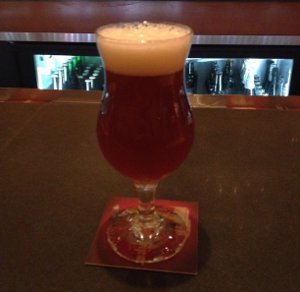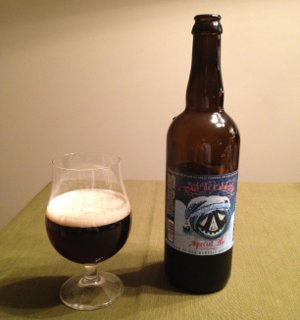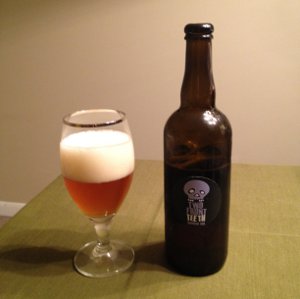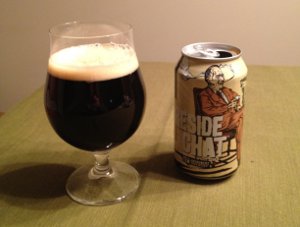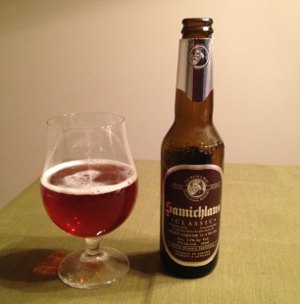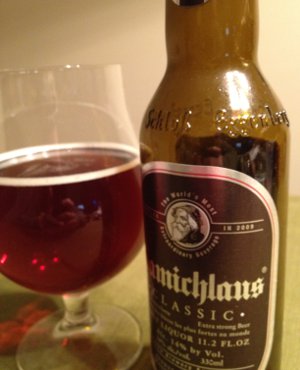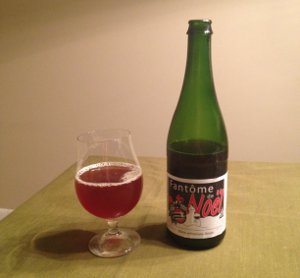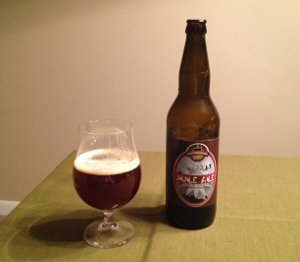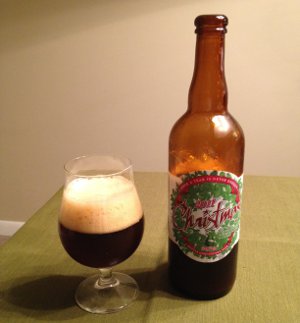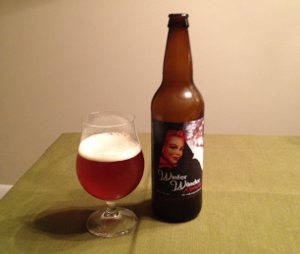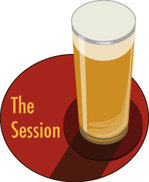 On the first Friday of every month, there’s a beer blog roundup called The Session. Someone picks a topic, and everyone blogs about it. This month, Mario wants to know what we drink when we’re not drinking beer:
On the first Friday of every month, there’s a beer blog roundup called The Session. Someone picks a topic, and everyone blogs about it. This month, Mario wants to know what we drink when we’re not drinking beer:
So as we are all incredibly interesting people, and almost always drink beer, let’s talk about what we drink when not drinking beer. Maybe your passion for coffee rivals that of craft beer, or it could be another alcoholic beverage such as Scotch. My daughter being a root beer fan would appreciate her dad reviewing a few fizzy sodas. Maybe you have a drink that takes the edge off the beer, be it hair of the dog or a palate cleanser during the evening.
Well, leaving aside the beer blog roundup of posts that aren’t about beer, I didn’t have much trouble picking my poison. A few years ago, and I would have said Coca-Cola. But then my doctor told me I drank too much Coke. And I won a basket of Scotch and Cigars. Warning: What follows is a long and arduous tale of how I came to enjoy Scotch, followed by a beer review (said beer having been aged in Scotch casks). Feel free to skip ahead if my blabbering is putting you to sleep.
Every year at work, we have a number of charity events, and for one of them, various teams put together a basket of goodies. People buy tickets and enter to win each basket. In the 7 or so years I’ve participated, I’ve won three times (the secret is to put your tickets in the bags with the least amount of tickets). There are always baskets of booze and beer, and they’re usually among the most entered baskets, but the Scotch and Cigar basket only had one bottle of scotch, so I’m guessing folks went for quantity over quality, and so I won and thus began my interest in scotch (and to a lesser extent, bourbon).
The Scotch I won was called The Balvenie. It’s a single malt Scotch, but unlike most single malt Scotches, The Balvenie comes from a single cask (I’m no expert, but usually multiple casks are filled with the whisky from a single malt, then blended together). It’s the 15 year old version, but it’s got a nice fancy label with all the relevant dates and whatnot, and as luck would have it, my particular bottle sat in the cask for 18 years (it was casked in 1990 and bottled in 2008).
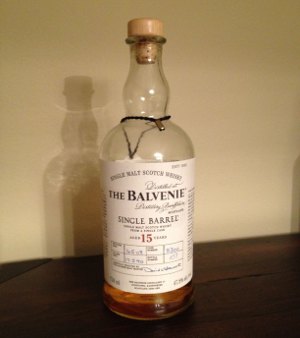
At the time, I was a little intimidated by the world of fine Scotch whisky. I didn’t want to waste this gorgeous and unique bottle of Scotch on an unrefined palate. Truth be told, it was right around this time that my beer geekery went into overdrive. I was learning a lot about beer, so I knew how different things could feel after you refined your palate a bit. So instead of cracking the Balvenie, I went out and bought some cheap Scotch. I started with a bottle of Johnnie Walker Black. A scotch whisky blend, and relatively cheap stuff with which to acquire a taste for scotch.
My initial strategy consisted of pouring a little bit of scotch in a glass, then filling most of the rest with water. Yeah, if a whisky nerd ever reads this, their head might explode, but this is why I got the Johnnie Walker. I would have one of these every day, but each day, I would decrease the amount of water. After a couple of weeks, I was drinking it straight up (like a real, fire-breathing man!) and enjoying myself quite a bit. I finally cracked open The Balvenie and basked in its glory.
During this period, my friend Padraic took pity on my scotch newbie soul and gave me the rundown (Padraic is a big beer nerd too, and he also maintains a blog about tea – quite the renaissance man!) He gave me a nice list of Scotches to try, and pointed me to a blog written by his friend Jacob called Water of Life (Padraic also contributes some reviews there). Thus armed with recommendations, I began exploring the world of Scotch a bit more.
It’s been slow going and I won’t pretend to be an expert. Beer is my poison of choice and I’ve probably only had 7 or 8 different scotches in my life. I only recently figured out that Islay is pronounced “eye-wah”. Speaking of which, I don’t know much about the various scotch regions either (though Islay seems to be home to the peaty, smoky monsters of Scotch). But I tell you now, every time I pour myself a dram of The Balvenie 15, I find my appreciation grows immensely. It is a really spectacular spirit, and I’m glad I still have some of it left. Oh sure, I could buy myself another bottle, but as it says on the label “Each bottle is unique and unrepeatable.”
But this is a beer blog, so to bring the subject back to beer, we’ll naturally have to talk about Scotch barrel aged beer! I’ve covered a few of these, ranging from the sublime to the merely brilliant to the awkwardly balanced to the outright disastrous. Today, I review one of Brewdog’s now defunct Paradox series. An intriguing idea – they brewed up some imperial stout, then aged it in varying brands of Scotch barrels. This one was aged in Smokehead barrels. It’s an Islay scotch, and apparently quite heavily peated, with lots of smoke. In my above referenced examples, Islay seems to overpower the flavors in beer, even in an imperial stout. But two examples isn’t exactly a big sample size, so here’s a third.
This one’s been sitting around for at least a year, so perhaps the flavors have had enough time to come together and harmonize or something. The bottle says this should be served “at room temperature, unless you live in an igloo.” In which case, I presume our Eskimo friends would have to find a way to warm up the beer. Fortunately, I don’t live in an igloo:
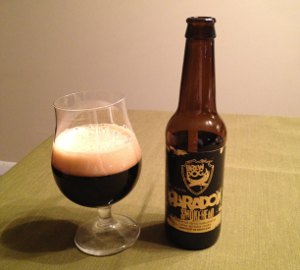
BrewDog Paradox Smokehead – Pours an extremely dark brown, almost black color with a couple fingers of light brown head. The aroma is dominated by peat smoke (as expected), with just a little musty yeast and roasted malt character shining through. That peaty smoke appears prominently in the taste as well, along with the corresponding scotch flavors, but you also get more of that roasted malt. Coffee and even chocolate make a welcome appearance towards the middle to finish, with a lingering aftertaste that actually works well. Mouthfeel is weird to judge. Feels very heavy and chewy, but that is perhaps due to the temperature (I don’t normally drink beer at room temperature). Overall, this is actually a damn good beer. I never really had a fresh bottle of this, but I suspect that the extra time on my shelf has done this beer a favor, and that it would get even better with additional aging. The flavors have actually married together well, though it is not quite the perfection of Ola Dubh 40 or Devine Rebel. That being said, I’m impressed and a little saddened that Brewdog doesn’t make these anymore. Perhaps I’ll still be able to find a bottle somewhere… B+
Beer Nerd Details: 10% ABV bottled (11.2 oz). Drank out of a tulip glass on 1/6/11. Bottle label says this is Batch 15, best drank before 19-8-16 (and unlike Storm, this one didn’t have a little sticker over the date!)
Well, there you have it. I wish I had a bottle of Smokehead to chase this with, but what are you going to do. I have about 5 bottles of scotch in my little liquor cabinet with varying degrees of glory left in the bottle. Since this is a strong beer, I may have to forego the Balvenie tonight and hit up the newly acquired Ardbeg 10, whose Islay smokeyness knows no bounds. Someday, perhaps, I will do more considered Scotch reviews (they would definitely make great candidates for a double feature) here, but for now, this post will have to do.
Update: The Roundup has been posted. As it turns out, I’m very unoriginal, as lots of beer folks apparently go for the occasional dram of scotch as well. Go figure.
